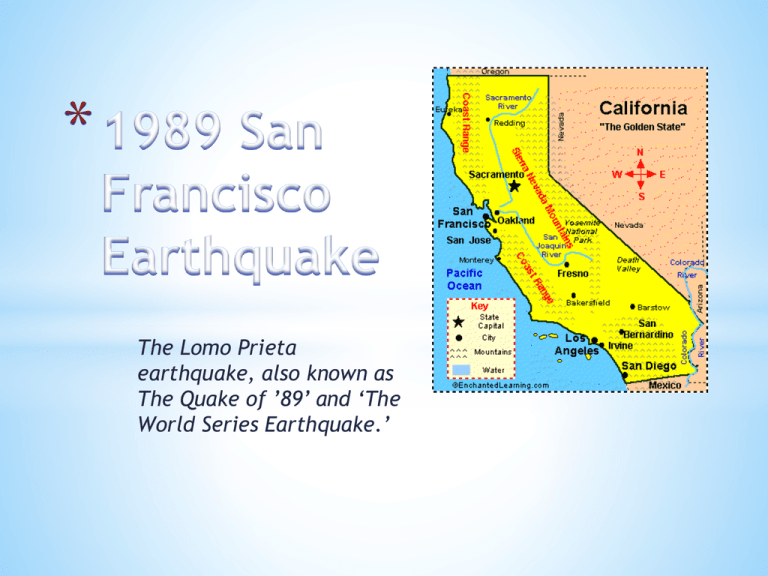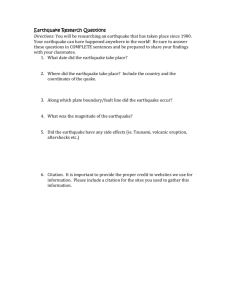File
advertisement

The Lomo Prieta earthquake, also known as The Quake of ’89’ and ‘The World Series Earthquake.’ The epicentre of the quake was in the Forest of Nisene Marks States Park in Santa Cruz County • The San Francisco Earthquake occurred on October 17th 1989 at 5:04pm (Local time) • It lasted 10-15 seconds • It measured 6.9 on the Richter Scale • It killed 63 people throughout northern California • 3,757 injured • 3,000-12000 left homeless The Earthquake occurred during a warm up practice for the 3rd game of the 1989 world series. Because of this, It was the first major earthquake in the U.S. to have its initial jolt broadcast live on T.V. The Highest number of fatalities (42) occurred in Oakland because of the Cypress Street viaduct collapse on the Nimitz Freeway. The Upper level of the freeway collapsed and crushed the cars on the lower deck. A 50 foot section of Oakland Bay Bridge collapsed. Pacific Garden Mall in Santa Cruz collapsed, which killed 3 people. 12,000 homes and 2,600 businesses were damaged At the Santa Cruz Beach Boardwalk, the Plunge building was severely damaged. Due to the earthquake… o In Santa Cruz 40 buildings collapsed killing 6 people o Sand Volcanoes formed in a field near Pajoro and in a strawberry field. The earthquake caused $6 billion in property damage, which made it one of the most expensive natural disaster in US history at the time On October 26th George H.W. Bush (president at the time) signed a $3.45 billion earthquake relief package for California. Immediately following the earthquake, San Francisco Bay Area airports closed to conduct visual inspection and damage assessment procedures. San Jose International Airport, Oakland International Airport and San Francisco International Airport all opened the next morning. Damage to the region’s transportation system was estimated at $1.8 billion • The Bay Bridge was repaired and reopened to traffic in a month. Construction on a replacement for the eastern span began in January 29th 2002. The project is expected to be finished in 2013. • The double-decked Cypress Street Viaduct was demolished soon after the earthquake, and was not rebuilt until 1997. The rebuilt highway was only a single rather than a double-deck structure and the route of the highway was also changed. Instead of bisecting West Oakland it re-routed around the outskirts. • State Route 17 : The mountain highway was closed for about a month because of a landslide. The earthquake crosses near the earthquakes epicentre. • San Francisco Municipal Railway lost all power to electric transit systems when the earthquake hit. But, luckily it suffered little damage and no injuries to operator or riders. • The earthquake caused enough damage that some parts of the region’s freeway system had to be demolished. The worst disaster of the earthquake was the collapse of the Cypress Street Viaduct in West Oakland. It killed 42 people and many more were injured. It was built the in the late 1950’s. During the earthquake, the freeway buckled and twisted to its limits before the support columns failed and the upper deck crashed to the lower deck. Instantly, 41 people were crushed to death inn their cars. On the upper deck, cars were being flipped and tossed around everywhere and some of them were left dangling on the edge of the Highway. There was many rescue workers and on October 21st a survivor Buck Helm was found in the wreckage after spending 90 hours trapped in his crushed car. Helm lived for another 29 days on life support but then died due to respiratory failure at the age of 57. Rebuilding the freeway took 11 years.






